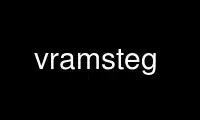
This is the command vramsteg that can be run in the OnWorks free hosting provider using one of our multiple free online workstations such as Ubuntu Online, Fedora Online, Windows online emulator or MAC OS online emulator
PROGRAM:
NAME
vramsteg - CLI progress bar
SYNOPSIS
To display/update a progress bar:
vramsteg --min <integer> --max <integer> --current <integer> [options]
To remove a progress bar:
vramsteg --remove
To capture the start time:
START=$(vramsteg --now)
To include elapsed time (which requires a start time):
vramsteg --start=$START --elapsed ...
To include estimated remaining time (which requires a start time):
vramsteg --start=$START --estimate ...
To use a specific bar width:
vramsteg --width 100 ...
To show the percentage completed:
vramsteg --percentage ...
To show a label at the beginning of the bar:
vramsteg --label This is a label ...
To use an alternate rendering style:
vramsteg --style <style-name> ...
DESCRIPTION
('progress' in Swedish, almost) is an open source, command line utility that provides
shell scripts with a full-featured progress indicator. The progress bar can display
elapsed time, remaining time estimate, percentage completed, and labels. The progress bar
can have user-specified colors, and be rendered in multiple styles.
If you have a shell script, or in fact any command line program that needs a progress bar,
vramsteg may be the right solution. Suppose you have a program that is performing a
lengthy operation, provided that it has an opportunity to execute vramsteg frequently,
then integrating a progress bar is simple.
You may have seen progress bars used to good effect in the rsync or scp commands, among
others.
EXAMPLES
Here is a complete bash shell script illustrating how vramsteg works, in the simplest
case:
#! /bin/bash
vramsteg --min 0 --max 4 --current 0
sleep 1
vramsteg --min 0 --max 4 --current 1
sleep 1
vramsteg --min 0 --max 4 --current 2
sleep 1
vramsteg --min 0 --max 4 --current 3
sleep 1
vramsteg --min 0 --max 4 --current 4
echo
Obviously this is a contrived example, but it illustrates how vramsteg is used to show a 4
step process. The --min and --max arguments specify what constitutes 0% and 100% of the
work, and are integer values. The --current argument represents where the progress bar is
at any moment. The example takes 4 seconds to complete, but those sleep commands are
proxies for whatever your program is doing.
A more realistic example involves looping. Here is a simple shell script loop that will
be used for a more complete example:
#! /bin/bash
for i in {0..10}
do
vramsteg --min 0 --max 10 --current $i
sleep 1
done
echo
Again, the sleep command represents the real work that is being done. Note that the
'echo' command at the end provides a newline character to prevent any text from
overwriting the bar. To remove the bar when done, the script becomes:
#! /bin/bash
for i in {0..10}
do
vramsteg --min 0 --max 10 --current $i
sleep 1
done
vramsteg --remove
Now the last list replaces the need for the 'echo' command.
There are two features that require some additional code. In order to display the elapsed
time, vramsteg needs to know the time when the process began. Because vramsteg is
stateless, the start time needs to be specified on every call, but first the start time
must be captured. There is a --now option that causes the current time (in epoch form) to
be displayed:
vramsteg --now
1276361315
This value needs to be captured by the shell script, like this:
START=$(vramsteg --now)
or
START=`vramsteg --now`
Then along with the --elapsed option, the start time is provided to each call of vramsteg
like this:
#! /bin/bash
START=$(../vramsteg --now)
for i in {0..10}
do
vramsteg --min 0 --max 10 --current $i --start $START --elapsed
sleep 1
done
vramsteg --remove
Because vramsteg is stateless, which means it doesn't record any information on disk, the
start time needs to be specified for every vramsteg call that makes use of it.
The other feature is an estimate of the remaining time, which is used in a similar
fashion:
#! /bin/bash
START=$(../vramsteg --now)
for i in {0..10}
do
vramsteg --min 0 --max 10 --current $i --start $START --estimate
sleep 1
done
vramsteg --remove
The estimated time only displays whole numbers of seconds, and because the --now option
also only returns whole seconds, there can be inaccuracies in the elapsed and estimated
time if process is fast.
By default, vramsteg uses 80 columns to display the progress bar. You may override this
by specifying a different width, but if you do, then you must also specify that width for
all vramsteg calls, such as:
vramsteg --remove --width 100
If you specify a width that is too small to include features like the label, percentage,
elapsed and estimated time, an error is reported.
If you enter the command:
vramsteg
without arguments, the command usage is displayed, including examples of progress bars in
the supported styles.
Use vramsteg online using onworks.net services
